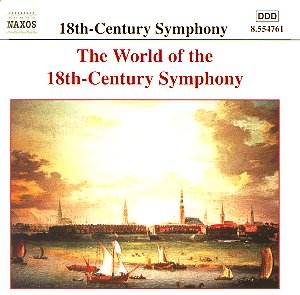The World of the 18th Century
Symphony
Johann
Stamitz. Symphony in F Major.
Op.1 No 4.a Allegro
molto. 3.19
Franz Beck. Symphony in E Major. Op. 13 No
1.a Allegro. 2.41
Christian Cannabich. Symphony No. 50 in D Minor.
Op.10 No 5b Allegro. 3.38
Francois-Joseph Gossec. Symphony in G Major.
Op.12 No 2.a Allegro 3.35
Carl Philipp Emanuel Bach. Symphony in B Flat Major.
No 2c (Complete) 12.04
Johann Christian Bach.
Symphony in D
Major. Op. 3 No 1d (Complete)
10.18
Leopold Hoffman. Symphony in F major (Badley
F2)a (Complete) 13.01
Carl Ditters von Dittersdorf. Symphony in G Major.
(Grave g1)e Allegro 8.53
Johann Baptist Vanhal. Symphony in D Major (Bryan
D17)b Andante molto-Allegro 7.44
Joseph Martin Kraus. Symphony in C 'Violin Obligato'
(VB138)f Adagio-Allegro
8.45
Northern Chamber Orchestra - Nicholas Ward. a Nicolaus
Esterhazy Sinfonia - Uwe Grodd b Capella Istropolitana - Christian
Bendac Camerata Budapest - Hanspeter Gmürd
Failoni Orchestra - Uwe Grodde Swedish Chamber Orchestra - Petter
Sundkvistf
Recording dates N/A. Naxos.8. 554761 [76.27]

Compilation discs are a fact of life to today's CD buyers. You either love
'em, or you just try to ignore 'em. Personally I seldom even look at them.
However, this Naxos offering under the title "The World of the
18th-Century Symphony" is a little bit different. It has a commercial
aim, naturally enough, but one that music lovers might well like to be made
aware of and to support in the future if they are not aware of it already.
Naxos intends to trawl what it sees and hopes to be a rich vein of untapped
music - namely the Eighteenth Century. In conjunction with a New Zealand
publishing house, Artaria Editions, which has in its list scores for eight
of the ten works on this disc ( not the C.P.E or J.C.Bach Symphonies) it
plans to seek out and market some of the mass of material available from
that period which we music lovers in general do not know.
No-one would dispute that Naxos knows its business. This is typified by the
comprehensive and highly informative notes with the disc written by Dr. Allan
Bradley. Amongst the information Dr. Bradley gives us is the frankly staggering
figure of over 16000 Symphonies from the Century, that he tells us have been
identified to date. The mind boggles. Obviously a large proportion will be
unknown because the sorting out that posterity has made already will be proved
to be right, but if just one percent even proves to be good enough to be
repertoire of the future that is still a lot of music new to us.
I would not normally refer to the notes supplied with a disc as liberally
as on this occasion, but this is that sort of CD. Dr. Bradley makes a good
point. He reminds us that in their time Mozart and Haydn had contemporaries
who were equally highly regarded and that re-listening to some of these forgotten
names might prove a valuable experience. He then goes on to describe the
fragmentation by styles of European music at the time.
Of the items on the disc itself, the pieces are divided into five groupings,
the Mannheim grouping, two of J.S.Bach's sons and the disparate music they
wrote, the then' Viennese School', and a single piece to represent the music
from Stockholm in the late 1770's.
The disc has three complete works and the rest are single movement extracts.
As is normal with compilations, all the tracks are from previously released
recordings from the current listings, and being Naxos, they are of course
all new digital recordings.
The composers we today associate with Mannheim had helped to build up an
exceptionally good orchestra at the Court there. Those original players built
up a repertoire full of demonstrations of technical skills and audience pleasing
stylistic traits. Stamitz is probably the best known name from that era and
he is featured along with three other representatives, and the single movement
of his work shows off the local speciality, the crescendo. Another
effect featured is the colourfully named Mannheim Rocket - a rising
triadic figure (you all knew that, of course, didn't you?) - included in
the Gossec extract. The Franz Beck and Cannabich movements belong to this
grouping.
A complete work by each shows differences between the styles of C.P.E. Bach
and his brother Johann Christian. The former's highly personal use of abrupt
stops is noticeable and the 'Italianate' approach of his brother -
lighter, more airy instantly appeals.
The Viennese School of its day felt that the Symphony as a form had
a future without what they saw as orchestral gimmicks. Haydn and his
contemporaries were proved right, of course, represented here on disc by
Dittersdorf, Hofman and Vanhal. The Hofman symphony (complete) is a charming
3 movement piece (from the man credited with the first four movement symphony)
while the extracts from von Dittersdorf and Vanhal each has some interest.
A single movement by Joseph Martin Kraus - chosen to reflect the influence
of the Court of Gustav 3rd in Stockholm - is notable for its solo
violin part - nearing what we might now think of as a concerto.
Altogether an interesting disc prelude to a series that one can only wish
well.
Reviewer
Harry Downey


![]()